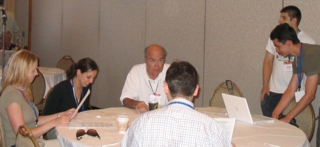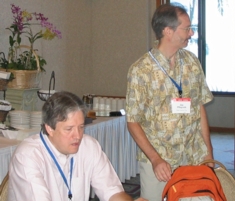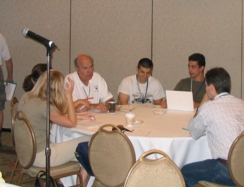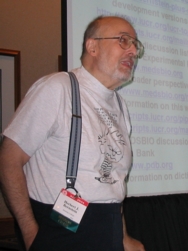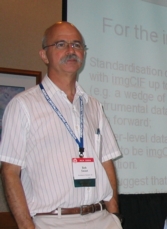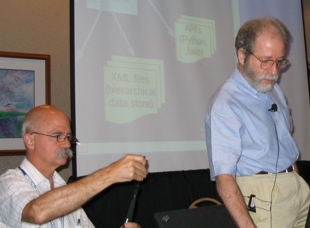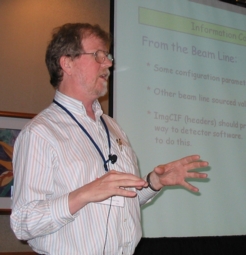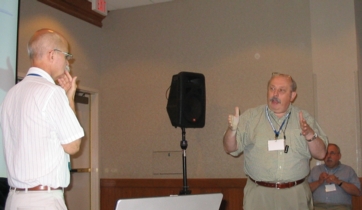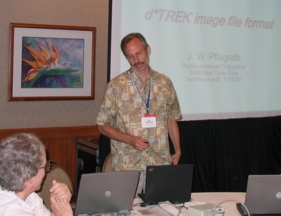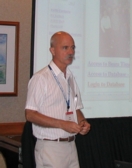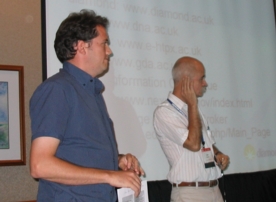| BioSync | MEDSBIO list | MEDSBIO list archive | Meetings |
| Make a Submission to the MEDSBIO web site |

![[IUCr Home Page]](../html_graphics/iucrhome.jpg)
![[MEDSBIO]](../html_graphics/MEDSBIO_button.jpg)
| IUCr Home Page
| CIF Home Page
| CBF
| NeXus
|
| BioSync
| MEDSBIO list
| MEDSBIO list archive
| Meetings
|
| Make a Submission to the MEDSBIO web site
|

at the 2006 Meeting of the American Crystallographic Association July 22 to July 27, 2006 in Honolulu, Hawaii
Herbert J. Bernstein, yaya@dowling.edu
Robert M. Sweet, sweet@bnl.gov
Sponsored by DOE under grant ER64212-1027708-0011962, NSF under grant DBI-0610407
and Area Detector Systems Corporation (ADSC)
and run thanks to the help and cooperation of the ACA, the ACA Continuing Education
Committee
and the ACA Data, Standards, and Computing Committee
Oahu Room, 8:30 am -- 5:00 pm, Saturday, 22 July 2006
Sheraton Waikiki, Honolulu, HI
The pace of data collection and the volume of data collected at synchrotron beam lines is increasing. The ACA Data, Standards, and Computing Committee is spearheading an effort to improve the efficiency of the handling and storage of these data by encouraging the adoption of common data formats and standard software interfaces. The goal of this is firstly to have the data be self defining, therefore equally accessible to data-reduction and -visualization codes. The second goal, for the purposes of secure archiving, is to provide robust internal documentation of the source of the data.
The first imgCIF/CBF workshop took place at Brookhaven National Laboratory in 1997 and proposed a format combining support for an efficient binary representation of images with a fully CIF-compliant ASCII equivalent. An imgCIF/CBF dictionary and software to support the format were created, are available on the web, and are described in Volume G of the IUCr International Tables for Crystallography. Now the community should adopt a consensus standard for management of data at synchrotron beam lines, and to make it easier for users to process data taken from various beam lines. Also, as our science evolves, new concepts will be considered: possibilities include NeXus and XML.
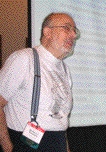 The first workshop in the new series, on "Management of Synchrotron Image Data: imgCIF File System and
Beyond", was held on 22 July 2006 as part of the 2006 ACA meeting in Honolulu,
Hawaii. The workshop was attended
by 39 participants and began with brief introductory talks in the morning by R.
Sweet, H. Bernstein, G. Bricogne, C. Nielsen, W. Minor, J. Pflugrath, R. Sweet,
A. Ashton, J. Westbrook, B. McMahon and T. Proffen.
The rest of the workshop was devoted to lively discussion
lead in alternation by Sweet and Bernstein and which produced a surprising
degree of consensus.
Productive
discussion continued, even after formal conclusion of the workshop, late into
the afternoon, despite the lure of the beach just outside the meeting
room.
The first workshop in the new series, on "Management of Synchrotron Image Data: imgCIF File System and
Beyond", was held on 22 July 2006 as part of the 2006 ACA meeting in Honolulu,
Hawaii. The workshop was attended
by 39 participants and began with brief introductory talks in the morning by R.
Sweet, H. Bernstein, G. Bricogne, C. Nielsen, W. Minor, J. Pflugrath, R. Sweet,
A. Ashton, J. Westbrook, B. McMahon and T. Proffen.
The rest of the workshop was devoted to lively discussion
lead in alternation by Sweet and Bernstein and which produced a surprising
degree of consensus.
Productive
discussion continued, even after formal conclusion of the workshop, late into
the afternoon, despite the lure of the beach just outside the meeting
room.
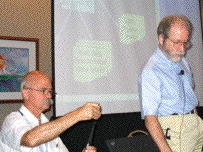 The charge to the workshop was to "Organize the
adoption of a standard, self-documenting format for diffraction image
files." Rather immediately, the
focus was on adoption of the current imgCIF/CBF standard that has been approved
by the IUCr COMCIFS. The format of
the meeting included eleven short talks, presenting a little history and
background, and then descriptions by investigators, with various backgrounds
and interests, of their own goals or apprehensions about adoption of the imgCIF
standard.
The charge to the workshop was to "Organize the
adoption of a standard, self-documenting format for diffraction image
files." Rather immediately, the
focus was on adoption of the current imgCIF/CBF standard that has been approved
by the IUCr COMCIFS. The format of
the meeting included eleven short talks, presenting a little history and
background, and then descriptions by investigators, with various backgrounds
and interests, of their own goals or apprehensions about adoption of the imgCIF
standard.
Talks in the imgCIF Workshop (WK.02)
Saturday, 22 July 2006, 8:30 am -- 5:00 pm, Oahu Room
(The pre-workshop agenda and charge is at http://www.medsbio.org/meetings/ACA_2006_WK02.html)
8:30 Definition of the problem
What are the objectives of this workshop? R. Sweet [handout]
8:50 Brief refresher on the structure and flexibility of imgCIF and available supporting
software and mechanisms for making changes to both. H. Bernstein [handout,
dictionary,
CBFlib]
...
10:00-12:20 Short (10-15 minutes) prepared statements (based primarily on handouts, rather
than visual aids) to help frame the discussion, tentatively:
What is the problem we should be solving? G. Bricogne
Issues for equipment vendors. C. Nielsen [handout]
Issues for data-red'n software developers. W. Minor [handout]
J. Pflugrath [handout]
Issues for beam-line software developers. R. Sweet
Issues for other software developers. A. Ashton [handout]
Issues for data archivists. J. Westbrook [handout]
Issues for CIF wonks. B. McMahon [handout,
ITVG imgCIF Extract]
Issues for relative to NeXus, HDF and XML. T. Proffen [handout,
State of NeXus paper]
The second segment of the meeting was open discussion on a range of topics:
The conclusions and recommendations of the workshop were:
While work on these issues is important and helps to explain the need for continued funding discussed in item 5, above, it is our strong belief that our primary focus must be on items 1 through 5, or the base for this other work will not be as firm as it should be.
Partial support was provided by the U.S. Department of Energy under grant ER64212-1027708-0011962, NSF under grant DBI-0610407 and Area Detector Systems Corporation (ADSC). The workshop was run thanks to the help and cooperation of the ACA, the ACA Continuing Education Committee and the ACA Data, Standards, and Computing Committee. The workshop would not have been a success without the hard work of the ACA Buffalo Office and the Hawaii meeting organizing committee. The support, cooperation and encouragement from all these sources are gratefully acknowledged.

